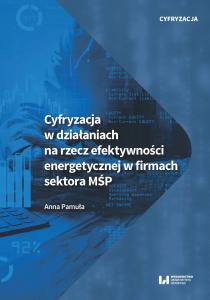-
892
-
880
-
873
-
870
-
804

Pliki do pobrania
Transformacja cyfrowa to kierunek, który zmienia nie tylko biznesowy sposób funkcjonowania, ale ma wpływ na wzrost efektywności energetycznej w organizacjach.
W monografii zawarto rozważania teoretyczne dotyczące potencjału przedsiębiorstw sektora MŚP w zakresie efektywności energetycznej oraz wpływu cyfryzacji na jego wykorzystanie. W sposób holistyczny przedstawiono w niej zagadnienia związane z cyfryzacją energetyki w powiązaniu z działaniami, jakie na rzecz efektywności mogą podejmować mikro, małe i średnie przedsiębiorstwa o różnym rodzaju działalności. Oprócz rozważań teoretycznych autorka przedstawia wyniki badań dotyczące zainteresowania i stopnia zaangażowania polskich przedsiębiorstw sektora MŚP w działania na rzecz EE. Monografia jest przeznaczona dla środowiska naukowego, ale szeroki zakres wiedzy znajdą w niej właściciele firm lub menadżerowie zainteresowani wprowadzaniem działań na rzecz EE.
Andersson E., Arfwidsson O., Bergstrand V., Thollander P. (2017), A study of the comparability of energy audit program evaluations. Journal of Cleaner Production, vol. 142, s. 2133–2139. DOI: 10.1016/j.jclepro.2016.11.070.
Antunes P., Carreira P.J., da Silva M.M. (2014). Towards an energy management maturity model. Energy Policy, vol. 73, DOI: 10.1016/j.enpol.2014.06.011.
ATKearney. Infrastruktura Sieci Domowej (ISD) w ramach Inteligentnych Sieci / HAN within Smart Grids. Raport Rynkowo-Społeczny. Pobrane z: https://www.ure.gov.pl/download/9/6347/Raportrynkowy-finalv4.pdf (dostęp: 12.10.2020).
Banks N., Fawcett T., Redgrove Z., Gunn M., Mullen J. (2012). What are the factors influencing energy behaviours and decision-making in the non-domestic sector. Pobrane z: https://www.cse.org.uk/downloads/reports-and-publications/behaviour-change/factors_influencing_energy_behaviours_in_non-dom_sector.pdf (dostęp: 20.08.2020).
BASEE (2020). Department for Business, Energy & Industrial Strategy. Pobrane z: https://www.gov.uk/government/publications/boosting-access-for-smes-to-energy-efficiency-basee-competition-winning-projects/basee-projects-selected-for-phase-2 (dostęp: 15.09.2020).
BiznesAlert (2018). Liczniki smart, jak to wygląda? Pobrane z: https://biznesalert.pl/liczniki-smart-jak-to-wyglada/ (dostęp: 15.09.2020).
Bodas-Freitas I.A., Corrocher N. (2019). The use of external support and the benefits of the adoption of resource efficiency practices: an empirical analysis of European SMEs. Energy Policy, vol. 132, s. 75–82. DOI: 10.1016/j.enpol.2019.05.019.
Brzóska J., Krannich M. (2016). Modele biznesu innowacyjnej energetyki, Studia Ekonomiczne. Zeszyty Naukowe Uniwersytetu Ekonomicznego w Katowicach, nr 280.
Buchmann M. (2017). Digital platforms in the energy sector – definition & first applications. Pobrane z: https://www.enerquire.com/blog/platforms-in-the-energy-sector-definition-and-potential-applications (dostęp: 10.07.2020).
Chan Y., Kantamaneni R. (2015). Study on Energy Efficiency and Energy Saving Potential in Industry from possible Policy Mechanisms, ICF International. Pobrane z: https://ec.europa.eu/energy/sites/ener/files/documents/151201%20DG%20ENER%20Industrial%20EE%20study%20-%20final%20report_clean_stc.pdf (dostęp: 15.05.2020).
Chebbo M., van Hove P., Hatziargyiou N. (2016). Digitalisation of energy: a vision becoming today a reality. Pobrane z: http://www.europeanenergyinnovation.eu/Articles/Spring-2016/Digitalisation-of-Energy-A-vision-becoming-today-a-reality (dostęp: 12.07.2020).
Christoffersen L.B., Larsen A., Togeby M. (2006). Empirical analysis of energy management in Danish industry. Journal of Cleaner Production, vol. 14.5, s. 515–526, DOI: 10.1016/j.jclepro.2005.03.017.
Christophe D. (2019). Enabling tomorrow’s power grid and new business models. Pobrane z: https://www.smart-energy.com/industry-sectors/smart-grid/enabling-tomorrows-power-grid-and-new-business-models/ (dostęp: 10.05.2020).
Contreras S. (2016). A multi-criteria decision method to prioritise energy improvement projects using sustainability criteria. Galway: National University of Ireland.
Cooremans C. (2013). Investment in Energy Efficiency by Large-Scale Consumers: an innovative audit programme, Conference: ECEEE. 2013 summer study on energy efficiency At: Presqu’île de Giens Toulon/Hyères, France vol. 2–459–13. Pobrane z: https://www.researchgate.net/publication/274640355_Investment_in_Energy_Efficiency_by_Large-Scale_Consumers_an_innovative_audit_programme (dostęp: 1.08.2020).
Cornelis E. (2019). History and prospect of voluntary agreements on industrial energy efficiency in Europe. Energy Policy, vol. 132, s. 567–582. DOI: 10.1016/j.enpol.2019.06.003.
Crossley D., Maloney M., Watt G. (2000). Developing Mechanisms for Promoting Demand-Side Management and Energy Efficiency in Changing Electricity Businesses, Research Report, No 3, Task VI of the International Energy Agency Demand-Side Management Programme, Energy Futures Australia Pty Ltd.
Digital platforms in the energy sector – definition & first applications (4.08.2017). Pobrane z: https://www.enerquire.com/blog/platforms-in-the-energy-sector-definition-and-potential-applications (dostęp: 12.10.2020).
Duch-Brown N., Rossetti F. (2020). Digital platforms across the European regional energy markets. Energy Policy, vol. 144. DOI: 10.1016/j.enpol.2020.111612.
Dyrektywa Parlamentu Europejskiego i Rady 2009/72/WE z dnia 13 lipca 2009 r. dotycząca wspólnych zasad rynku wewnętrznego energii elektrycznej i uchylająca dyrektywę 2003/54/WE (Dz.U. UE L 09.211.55).
Dzienniki UE (2019). Wdrożenie nowych przepisów z zakresu opomiarowania i rozliczeń zawartych w dyrektywie 2012/27/UE w sprawie efektywności energetycznej. Pobrane z: https://sip.lex.pl/akty-prawne/dzienniki-UE/wdrozenie-nowych-przepisow-z-zakresu-opomiarowania-i-rozliczen-zawartych-w-69235864 (dostęp: 6.08.2020).
Eco-Bot (2020). Personalised ICT-tools for the Active Engagement of Consumers Towards Sustainable Energy. Pobrane z: https://cordis.europa.eu/project/id/767625 (dostęp: 15.06.2020).
EFFI (2009). Making energy services SME attractive. Implementation of energy services in small and medium sized enterprises – EFFI. Publishable Report, Ljubljana, April 2009. Pobrane z: https://ec.europa.eu/energy/intelligent/projects/sites/iee-projects/files/projects/documents/effi_publishable_final_report.pdf (dostęp: 10.08.2020).
Engine (2010). Energy efficiency in small and medium-sized enterprises (ENGINE). Pobrane z: https://ec.europa.eu/energy/intelligent/projects/en/projects/engine (dostęp: 10.06.2020).
Farell T. (2018). Wywiad – Efektywność energetyczna jest korzystna dla wszystkich. Europejska Agencja Środowiskowa. Pobrane z: https://www.eea.europa.eu/pl/sygna142y/sygnaly-2017/artykuly/wywiad-2013-efektywnosc-energetyczna-jest (dostęp: 15.10.2018).
Fawcett T., Hampton S. (2020). Why & how energy efficiency policy should address SMEs. Energy Policy, vol. 140, 111337. DOI: 10.1016/j.enpol.2020.111337.
Fawcett T., Rosenow J., Bertoldi P. (2019). Energy efficiency obligation schemes: their future in the EU. Energy Efficiency, vol. 12, s. 57–71. DOI: 10.1007/s12053-018-9657-1.
Finnerty N., Sterling R., Coakley D., Keane D., Keane M.M. (2017). An energy management maturity model for multi-site industrial organizations with a global presence. Journal of Cleaner Production, vol. 167, DOI: 10.1016/j.jclepro.2017.07.192.
Finnerty N., Sterling R., Contreras S., Coakley D., Keane D., Marcus M. (2018). Defining corporate energy policy and strategy to achieve carbon emissions reduction targets via energy management in non-energy intensive multi-site manufacturing organizations. Energy, Elsevier, vol. 151(C), s. 913–929. DOI: 10.1016/j.energy.2018.03.070.
Fleiter T. (2012). The adoption of energy-efficient technologies by firms. An integrated analysis of the technology, behavior and policy dimensions. Fraunhofer Verlag.
Gajewski J., Paprocki W., Pieriegud J. (red.) (2016). Cyfryzacja gospodarki i społeczeństwa – szanse i wyzwania dla sektorów infrastrukturalnych. Instytut Badań nad Gospodarką Rynkową – Gdańska Akademia Bankowa. Pobrane z: https://depot.ceon.pl/bitstream/handle/123456789/11162/Pieriegud_Cyfryzacja_2016.pdf?sequence=1&isAllowed=y (dostęp: 6.03.2020).
Gawer A. (2009). Platforms, markets and innovation. DOI: 10.4337/9781849803311.
Gawer A., Cusumano M.A. (2014). Industry platforms and ecosystem innovation. Journal of Production Innovation Management, vol. 31(3), s. 417–433. DOI: 10.1111/jpim.12105.
Gillingham K., Karen P. (2013), Bridging the Energy Efficiency Gap. Insights for Policy from Economic Theory and Empirical Analysis. Disscussion Paper. Pobrane z: https://media.rff.org/archive/files/sharepoint/WorkImages/Download/RFF-DP-13-02.pdf (dostęp: 11.07.2020).
Globenergia (2019). https://globenergia.pl/audyt-energetyczny-dla-msp-nowy-obowiazek/ (dostęp: 11.08.2020).
Głuszek A. (2019). Efektywność energetyczna na maksa! CIRE. Pobrane z: https://www.cire.pl/item,180141,2,0,0,0,0,0,efektywnosc-energetyczna-na-maksa.html (dostęp: 15.09.2020).
Goldbach K., Rotaru A.M., Reichert S., Stiff G., Gölz S. (2018). Which digital energy services improve energy efficiency? A multi-criteria investigation with European experts. Energy Policy, vol. 115, s. 239–248. DOI: 10.1016/j.enpol.2017.12.036.
Gramwzielone (2019). Polski rynek usług ESCO warty 200 mln zł. Pobrane z: https://www.gramwzielone.pl/trendy/101124/polski-rynek-uslug-esco-warty-200-mln-zl (dostęp: 15.03.2020).
Horbach J. (2016). Empirical determinants of eco-innovation in European countries using the community innovation survey. Environmental Innovation and Societal Transitions, vol. 19, s. 1–14. DOI: 10.1016/j.eist.2015.09.005.
Hrovatin N., Dolšak N., Zorić J. (2016). Factors impacting investments in energy efficiency and clean technologies: empirical evidence from Slovenian manufacturing firms. Journal of Cleaner Production, vol. 127, s. 475–486. DOI: 10.1016/j.jclepro.2016.04.039.
IEA (2017). Digitalization and Energy, International Energy Agency, Paris. Pobrane z: https://www.iea.org/reports/digitalisation-and-energy https://webstore.iea.org/download/direct/269 (dostęp: 12.10.2020).
Introna V., Cesarotti V., Benedetti M., Biagiotti S., Rotunno R. (2014). Energy Management Maturity Model: an organizational tool to foster the continuous reduction of energy consumption in companies. Journal of Cleaner Production, vol. 83, s. 108–117. DOI: 10.1016/j.jclepro.2014.07.001.
Jaffe A., Stavins R. (1994a). Energy-efficiency gap. What does it mean? Energy Policy, vol. 22(10), s. 804–810. Pobrane z: https://scholar.harvard.edu/files/stavins/files/the_energy_efficiency_gap.pdf (dostęp: 1.12.2020).
Jaffe A., Stavins R. (1994b). Energy-efficiency investments and public policy. The Energy Journal, vol. 15, issue 2, s. 43–66.
Jakob M. (2006). Marginal costs, cost dynamics and co-benefits of energy efficiency investments in the residential buildings sector. Energy Policy, vol. 34, s. 172–187.
Jovanović B., Filipović J. (2016). ISO 50001. Standard-based energy management maturity model – proposal and validation in industry. Journal of Cleaner Production, vol. 112, part 4, s. 2744–2755. DOI: 10.1016/j.jclepro.2015.10.023.
Kalantzis F., Revoltella D. (2019). Do energy realize energy-efficiency audits help SMEs to opportunities? Energy Economics, vol. 83, s. 229–239. DOI: 10.1016/j.eneco.2019.07.005.
Kammerer D. (2009). The Effects of Customer Benefit and Regulation on Environmental Product Innovation. Ecological Economics, vol. 68(8–9), s. 2285–2295. DOI: 10.1016/j.ecolecon.2009.02.016.
Karbownik K. (2017). Możliwości wykorzystania kwestionariuszy badawczych w zarządzaniu. Zeszyty Naukowe Politechniki Częstochowskiej. Zarządzanie, t. 2, nr 25, s. 176–183.
Kloppenburg S., Boekelo M. (2019). Digital platforms and the future of energy provisioning: Promises and perils for the next phase of the energy transition. Energy Research & Social Science, vol. 49. DOI: 10.1016/j.erss.2018.10.016.
Koszyrek-Cyra A. (2016). Systemy zarządzania energią jako narzędzie wspierające proces racjonalizacji zużycia energii w organizacjach. Zeszyty Naukowe Politechniki Częstochowskiej. Zarządzanie, nr 22, s. 210–217. Pobrane z: http://www.zim.pcz.pl/znwz (dostęp: 10.08.2020).
Krajowy plan na rzecz energii i klimatu na lata 2021–2030. Założenia i cele oraz polityki i działania (18.12.2019). Ministerstwo Aktywów Państwowych. Pobrane z: http://www.gov.pl
Kuch D., Stringer N., Marshall L., Young L., Roberts M., Macgill I., Bruce A., Passey R. (2019). An energy data manifesto, s. 77–93. W: A. Daly, M. Mann, S.K. Devitt (red.). Good Data. Amsterdam: Institute of Network Cultures.
Kurt T., Tautor H. Transformacja sektora energetycznego: następuje era cyfryzacji i rozproszonych źródeł energii, WAGO. Pobrane z: https://www.wago.com/pl/rozwiazania/energetyka/cyfrowy-rynek-energii/wywiad-transformacja-rynku-energetycznego (dostęp: 12.12.2020).
Langea S., Pohlc J., Santariusa T. (2020). Digitalization and energy consumption. Does ICT reduce energy demand? Ecological Economics, vol. 176, 106760. DOI: 10.1016/j.ecolecon.2020.106760.
Leszczyńska A., Lee K-H. (2016). Źródła i bariery efektywności energetycznej polskich przedsiębiorstw. Annales H – Oeconomia. DOI: 10.17951/h.2016.50.3.105.
Levine M.D., Koomey J.G., McMahon J.E. Sanstad A.H., Hirt E. (1995). Energy efficiency policy and market failures. Annual Review of Energy and the Environment, vol. 20(1), s. 535–555. Pobrane z: https://www.annualreviews.org/doi/pdf/10.1146/annurev.eg.20.110195.002535 (dostęp: 12.12.2020).
Lista dostępnych dostawców usług związanych ze zużyciem energii. Ministerstwo Klimatu i Środowiska. Pobrane z: https://www.gov.pl/web/klimat/lista-dostepnych-dostawcow-uslug-energetycznych (dostęp: 15.02.2021).
MAP (2019). Wsparcie techniczne dla promowania audytu energetycznego oraz inwestycji w efektywność energetyczną w małych i średnich przedsiębiorstwach. Ministerstwo Aktywów Państwowych, Pobrane z: https://www.gov.pl/web/aktywa-panstwowe/promowanie-audytow-energetycznych-w-msp (dostęp: 15.10.2020).
Martínez C. (2011). Energy efficiency development in German and Colombian non-energy-intensive sectors: a non-parametric analysis. Energy Efficiency, vol. 4, s. 115–131, DOI: 10.1007/s12053-010-9078-2.
Martusewicz J., Szumowski W. (2018). Modele dojrzałości a modele doskonałości. Niezależność czy współzależność na drodze do rozwoju organizacji. Organizacja i Kierowanie, nr 1(180). Pobrane z: http://kolegia.sgh.waw.pl/pl/KZiF/czasopisma/oik/numery/Documents/2018_1_180/martusewicz-szumowski-modele-dojrzalosci-modele-doskonalosci-niezale%C5%BCnosc-czy-wspolzaleznosc-na-drodze-do-rozwoju.pdf (dostęp: 20.10.2020).
Mengelkamp E., Notheisen B., Beer C., Dauer D., Weinhardt C. (2018). A blockchain-based smart grid: towards sustainable local energy markets. Comput Sci Res Dev, vol. 33, s. 207–214. DOI: 10.1007/s00450-017-0360-9.
Ministerstwo Energii (2017). Koncepcja funkcjonowania klastrów energii w Polsce. Pobrane z: https://www.teraz-srodowisko.pl/media/pdf/aktualnosci/3164-koncepcja-funkcjonowania-klastrow-energii-w-polsce.pdf (dostęp: 30.08.2018).
Ngai E.W.T, Chau D.C.K., Poon J.K.L., To C.K.M. (2013). Energy and utility management maturity model for sustainable manufacturing process, International Journal of Production Economics, vol. 146, issue 2, s. 453–464, DOI: 10.1016/j.ijpe.2012.12.018.
O’Keeffe J.M., Gilmour D., Simpson E. (2016). A network approach to overcoming barriers to market engagement for SMEs in energy efficiency initiatives such as the GreenDeal. Energy Policy, vol. 97, s. 582–590. DOI: 10.1016/j.enpol.2016.08.006.
Oliveira M.A., Lopes I. (2019). Evaluation and improvement of maintenance management performance using a maturity model. International Journal of Productivity and Performance Management. DOI: 10.1108/IJPPM-07-2018-0247.
O’Sullivan J. (2012). Energy Management Maturity Model (EM3) – A Strategy to Maximize the Potential for Energy Savings through EnMS. 66.
Pacheco D.A. de J., Chwengber ten Caten C., Jung C.F., Sassanelli C., Terzi S. (2019). Overcoming barriers towards sustainable product-service systems in small and medium-sized enterprises: State of the art and a novel Decision Matrix. Journal of Cleaner Production, vol. 222, s. 903–921. DOI: 10.1016/j.jclepro.2019.01.152.
Palm J., Backman F. (2020). Energy efficiency in SMEs: overcoming the communication barrier. Energy Efficiency. DOI: 10.1007/s12053-020-09839.
Pamuła A. (2016a). Potencjał analiz Big Data w procesach obsługi odbiorców energii, Roczniki Kolegium Analiz Ekonomicznych (1232–4671), nr 40, s. 285–297
Pamuła A. (2016b). Rozwój usług niematerialnych w polskich przedsiębiorstwach energetycznych. Zeszyty Naukowe. Organizacja i Zarządzanie, nr 97, 1641–3466, s. 225–238.
Pamuła A. (2017a). Knowledge transfer methods applied on polish energy innovation and efficiency platforms. Zeszyty Naukowe. Organizacja i Zarządzanie, nr 114/7, 1641–3466, 7, s. 393–403.
Pamuła A. (2017b). Informacja jako wartość dodana w usługach dla odbiorców energii. Roczniki Kolegium Analiz Ekonomicznych, nr 45, 1232–4671, s. 93–105.
Pamuła A. (2020). Energy Efficiency Clusters and Platforms as a Potential for SMEs Development: Poland Case Study. Eurasian Business Perspectives, nr 14/2, 2364–5067.
Papetti A., Marilungo E., Gregori F., Germani M. (2016). Driving process innovation: a structured method for improving efficiency inSMEs. Procedia CIRP, vol. 50, s. 448–453. DOI: 10.1016/j.procir.2016.04.143.
Prashar A. (2017a). Adopting PDCA (Plan-Do-Check-Act) cycle for energy optimization, in energy-intensive SMEs. Journal of Cleaner Production, vol. 145, 277e293.
Prashar A. (2017b). Energy efficiency maturity (EEM) assessment framework for energy-intensive SMEs: Proposal and evaluation. Journal of Cleaner Production, vol. 166, 1187e1201. DOI: 10.1016/j.jclepro.2017.08.116.
Pye M., McKane A. (2000). Making a stronger case for industrial energy efficiency by quantifying non-energy benefits, resources. Conservation and Recycling, vol. 28, iss. 3–4, s. 171–183. DOI: 10.1016/S0921-3449(99)00042-7.
Rasolomampionona D., Robak S., Chmurski P., Tomasik G. (2010). Przegląd istniejących mechanizmów DSR stosowanych na rynkach energii elektrycznej. Rynek Energii, nr 4.
Rączka J. (2010). Efektywność energetyczna szansą na podniesienie konkurencyjności polskiego przemysłu. Pobrane z: http://www.nfosigw.gov.pl (dostęp: 15.10.2020).
Reddy A.K.N., (1991). Barriers to improvements in energy efficiency. Energy Policy, vol. 19, issue 10, s. 953–961. DOI: 10.1016/0301-4215(91)90115-5.
Reddy S.B. (2002). Barriers to the diffusion of renewable energy technologies, monograph. Centre for Energy and Environment/UNEP, Roskilde, Denmark.
Reddy S.B. (2013). Barriers and drivers to energy efficiency – A new taxonomical approach. Energy Conversion and Management, vol. 74, s. 403–416. DOI: 10.1016/j.enconman.2013.06.040.
Renewable energy statistics. Eurostat. Pobrane z: https://ec.europa.eu/eurostat/statistics-explained/index.php?title=Renewable_energy_statistics (dostęp: 15.01.2021).
Rodríguez-Molina J., Martinez-Nuñez M., Martínez J.F., Pérez-Aguiar W. (2014). Business models in the smart grid: Challenges, opportunities and proposals for prosumer profitability. Energies, vol. 7, s. 6142–6171. DOI: 10.3390/en7096142.
Rohdin, P., Thollander, P. (2006), Barriers to and driving forces for energy efficiency in the non-energy intensive manufacturing industry in Sweden. Energy, vol. 31 s. 1836–1844. DOI: 10.1016/j.energy.2005.10.010.
Santalla H. (2016). Ile jest rodzajów audytów energetycznych? (26 stycznia). Pobrano z: https://leonardo-energy.pl/baza-wiedzy/ile-jest-rodzajow-audytow-energetycznych/ (dostęp: 10.10.2020)
Schleich J., Fleiter T. (2019). Effectiveness of energy audits in small business organizations. Resource and Energy Economics, vol. 56, s. 59–70. DOI: 10.1016/j.reseneeco.2017.08.002.
Schleich J., Gruber E. (2008). Beyond case studies: Barriers to energy efficiency in commerce and the services sector. Energy Economics, vol. 30, issue 2, s. 449–464. DOI: 10.1016/j.eneco.2006.08.004.
Schor J. (2017). Does the sharing economy increase inequality within the eighty percent?: findings from a qualitative study of platform providers, economics. Cambridge Journal of Regions. Pobrane z: https://www.bc.edu/content/dam/files/schools/cas_sites/sociology/pdf/SharingEconomyInequality.pdf (dostęp: 17.12.2020).
Segarra-Blasco A., Jové-Llopise E. (2019). Determinants of energy efficiency and renewable energy in European SMEs. Economics of Energy & Environmental Policy, vol. 8, no. 2. DOI: 10.5547/2160-5890.8.2.aseg.
Słupik S. (red.) (2018). Deliverable 2.2. Taxonomy of energy efficiency models. Pobrane z: http://eco-bot.eu/wp-content/uploads/2019/04/ECO-BOT_D2.2_Taxonomy-of-energy-efficiency-models.pdf (dostęp: 10.10.2020).
Smutek H .(2001). Identyfikacja potencjału menadżerskiego. Zeszyty Naukowe AE w Krakowie, nr 567, s. 55.
Solnørdal M.T., Foss L. (2018). Closing the energy efficiency gap-a systematic review of empirical articles on drivers to energy efficiency in manufacturing firms. Energies, vol. 11(3). DOI: 10.3390/en11030518.
Soroka J.M. (2011). Społeczna odpowiedzialność przedsiębiorstw a role menadżerskie. Zeszyty Naukowe Wyższej Szkoły Bankowej we Wrocławiu, nr 22.
Sorrell S., O’Malley E., Schleich J., Scott S. (2004). The economics of energy efficiency: barriers to cost-effective investment. JO-Fraunhofer ISI ER. Pobrane z: https://www.researchgate.net/publication/43185108_The_Economics_of_Energy_Efficiency_Barriers_to_Cost-Effective_Investment (dostęp: 20.08.2020).
Sowa-Hawdziejuk S. (2020). Comarch IoT. Rola systemów smart metering perspektywy 2020–2040. Pobrane z: https://www.comarch.pl/files-pl/file_584/PL_White_Paper_Smart_Metering.pdf (dostęp: 13.10.2020).
Start2Act. Kontrola zużycia energii: pomiary i monitorowanie. Pobrane z: https://pl.start2act.eu/online-energy-saving-platform/knowledge-base/5/track-your-energy-use-metering-and-monitoring/sme/manager (dostęp: 6.10.2020).
Thiede S., Posselt G., Herrmann C. (2013). SME appropriate concept for continuously improving the energy and resource efficiency in manufacturing companies. Journal of Manufacturing Science and Technology, vol. 6, s. 204–211. DOI: 10.1016/j.cirpj.2013.02.006.
Thollander P., Ottosson, M. (2008). An energy efficient Swedish pulp and paper industry – Exploring barriers to and driving forces for cost-effective energy efficiency investments. Energy Efficiency, vol. 1, s. 21–34. DOI: 10.1007/s12053-007-9001-7.
Thollander P., Palm, J. (2013). Improving Energy Efficiency in Industrial Energy Systems: An Interdisciplinary Perspective on Barriers, Energy Audits, Energy Management, Policies, and Programs. Springer-Verlag London, DOI: 10.1007/978-1-4471-4162-4.
Thollander P., Paramonowa S., Cornelis E., Kimura O., Trianni A., Karlsson M., Cagno E., Morales I., Jimenez J.P. (2015). International study on energy end-use data among industrial SMEs (small and medium-sized enterprises) and energy end-use efficiency improvement opportunities. Journal of Cleaner Production. DOI: 10.1016/j.jclepro.2015.04.073.
Thumann A., Niehus T., Younger W.J. (2012). Handbook of Energy Audits, Fairmont Press.
Trianni A., Cagno E., Farne S. (2016). Barriers, drivers and decision-making process for industrial energy efficiency: a broad study among manufacturing small and medium-sized enterprises. Appl. Energy, vol. 162, 1537e1551.
Tricoire J.P. (2019). Cyfryzacja pomaga oszczędzać energię. Pobrane z: https://www.rp.pl/Biznes/191019382-Cyfryzacja-pomaga-oszczedzac-energie.html (dostęp: 2.04.2020).
Usługi energetyczne typu ESCO na polskim rynku. Pobrane z: https://dane.gov.pl/pl/dataset/1727,usugi-energetyczne-typu-esco-na-polskim-rynku (dostęp: 15.01.2021).
Ustawa o efektywności energetycznej z 20 maja 2016 r. (art. 2, Dz.U. 2016, poz. 831 tekst jednolity).
Weber L. (1997). Some reflections on barriers to the efficient use of energy. Energy Policy, s. 833–83. DOI: 10.1016/S0301-4215(97)00084-0.
Weigel P., Fischedick M. (2019). Review and categorization of digital applications in the energy sector, Applied Science, vol. 9, 5350. DOI: 10.3390/app9245350.
Weiller C.M., Pollitt M.G. (2013). Platform markets and energy services EPRG Working Paper 1334 Cambridge Working Paper in Economics 1361. Pobrano z: https://www.eprg.group.cam.ac.uk/wp-content/uploads/2013/12/1334-PDF.pdf (dostęp: 15.07.2020).
Worrell E., Laitner J.A, Ruth M., Finman H. (2003). Productivity benefits of industrial energy efficiency measures. Energy, vol. 28, iss, 11, s. 1081–1098. DOI: 10.1016/S0360-5442(03)00091-4.
Woźniak L., Strojny J., Wojnicka E. (2010). Ekoinnowacje w praktyce funkcjonowania MŚP. Pobrano z: https://www.parp.gov.pl/component/publications/publication/ekoinnowacje--w-praktyce--funkcjonowania-msp (dostęp: 4.08.2020).
Zhou L., Li J., Li F., Meng Q., Li J., Xu X. (2016). Energy consumption model and energy efficiency of machine tools: a comprehensive literature review. Journal of Cleaner Production, vol. 112, Part 5, s. 3721–3734. DOI: 10.1016/j.jclepro.2015.05.093

Utwór dostępny jest na licencji Creative Commons Uznanie autorstwa – Użycie niekomercyjne – Bez utworów zależnych 4.0 Międzynarodowe.
| Mapa strony | Księgarnia | Social Media |
42 635 55 77 42 235 01 62 ksiegarnia@uni.lodz.pl Biuro: 42 235 01 65 42 635 55 80 agnieszka.janicka@uni.lodz.pl Polityka prywatności i cookies © 2024 Uniwersytet Łódzki |
    |


